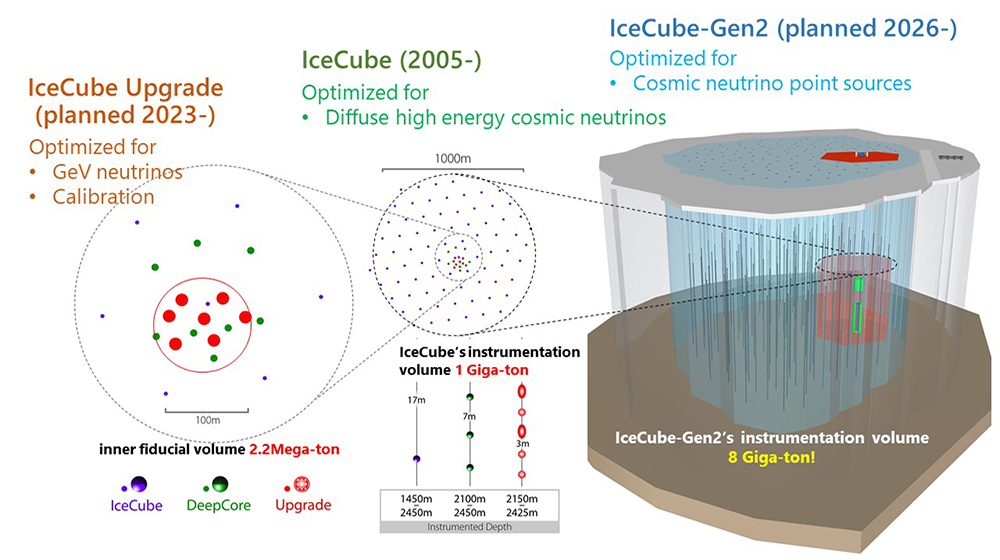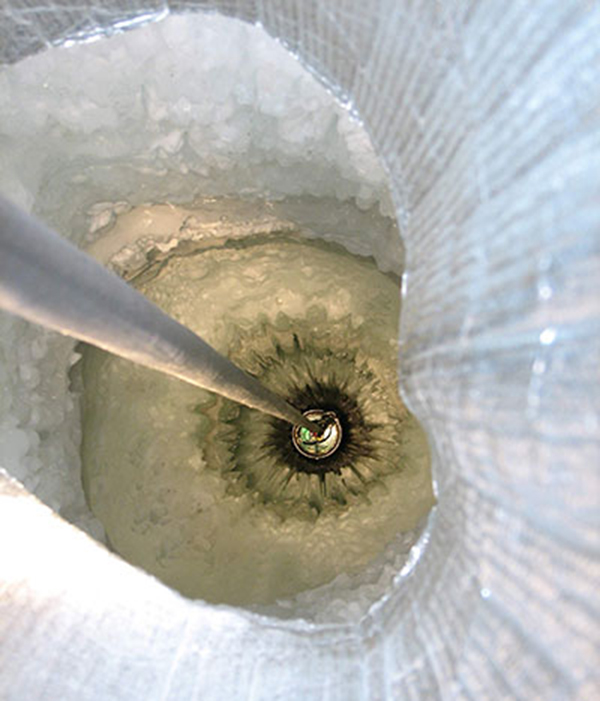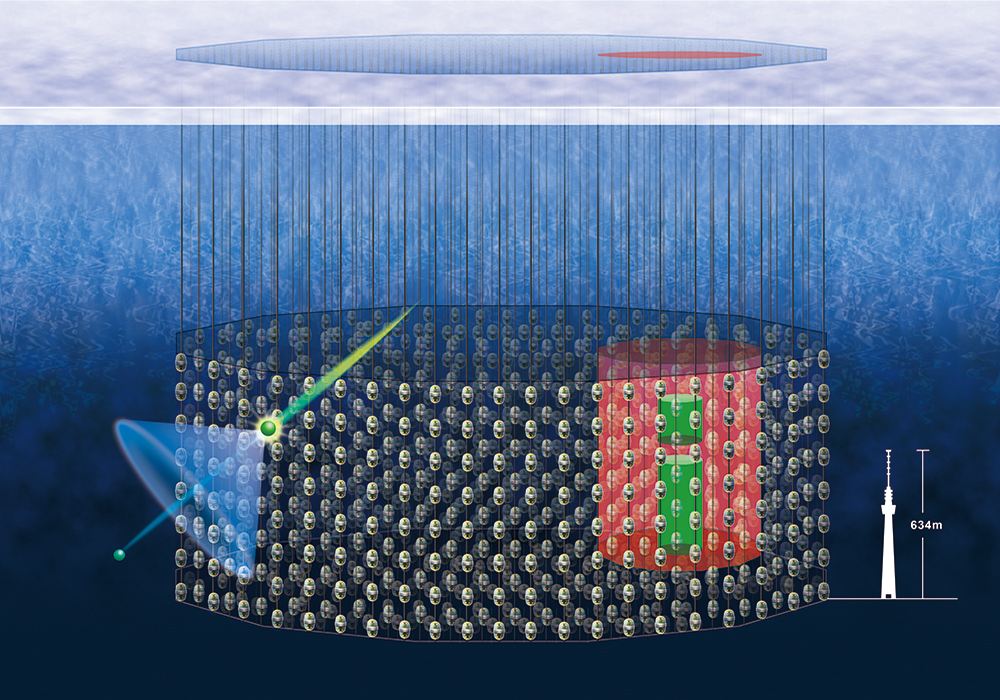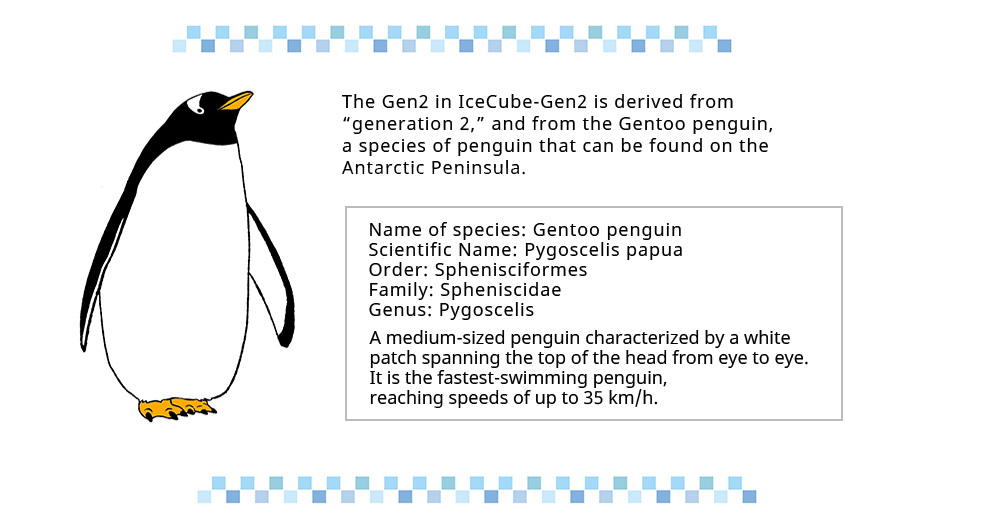The IceCube Observatory has been running at full capacity since 2011. There are currently two plans to take IceCube to the next stages in its evolution.
The first, called IceCube Upgrade, is due to start in 2022. The second is called IceCube-Gen2, and it is planned to stand as the next generation of neutrino observatories.
The IceCube Upgrade plan will add seven new holes to the area where the IceCube DOMs are buried. Approximately 700 new high-performance detectors will be buried there along with calibration devices, and the distance between detectors will be less than that in the current array. (Shown in the red circle on the left side of the illustration below.)

©IceCube Collaboration
This will reduce the number of systematic uncertainties that are associated with observations, including those from uncertainties in light propagation properties within the South Pole ice, thereby improving performance during observation of low-energy neutrinos.
The new, high-performance photodetectors due to be buried in the ice in 2022 include D-Egg photodetectors developed by the Chiba University group. Approximately 300 D-Eggs will be sent to the South Pole to be embedded at the observatory alongside other detectors and calibrators developed at universities in Germany and the US. D-Eggs are currently being built and resistance-tested in preparation for work on IceCube Upgrade to begin (as of 2020).
The new D-Egg has implemented a number of improvements over the current DOMs. For example, each DOM contains a single downward-facing photomultiplier tube (PMT), the key component of the photodetector, while each D-Egg has two, one facing up and one down. In addition, where the DOMs are spherical in shape, the D-Eggs are egg-shaped, just as their name suggests.
The D-Eggs are slimmer, with a diameter of 25 cm compared to the approximately 30 cm diameter of the DOMs. This will have the advantage of lowering the enormous drilling costs needed to embed the detectors in the ice by around 20%. They will also have better performance as they have a vastly higher detection efficiency when detecting Cherenkov radiation incident from above, with three times more sensitivity.

©Mark Krasberg,IceCube/NSF
A DOM being lowered into the ice.
Opening the holes in the ice is achieved by injecting water at 80°C from the tip of the drill, melting the hard ice as it goes, continuing down to a depth of 2.5 km.
The holes are left full of hot water, so the detectors connected by the string are submerged one after another.
When the D-Eggs are embedded in the ice, the hole will have a smaller diameter, so the cost of drilling will be reduced.
Three years after the completion of IceCube Upgrade, construction of the next-generation neutrino observatory IceCube-Gen2 is scheduled to begin. It is planned to take around ten years to complete, with partial operations of the observatory starting six years after construction begins.
The new detectors will be buried in the area around and enclosing the current IceCube detector array (the red region in the illustration below), which will improve performance and enable accurate detection of more neutrino events.

For IceCube-Gen2, approximately 10,000 photodetectors will be buried in the ice, double the amount currently deployed in the IceCube array (the green region in the illustration above.) The detection volume will be roughly eight times larger, increasing neutrino point source sensitivity by more than five times. The goal is to enable the identification of even more neutrino sources.

Begin D-Egg fabrication (approximately 300 units)
IceCube Upgrade construction begins.
A total of 700 new high-performance detectors, included 300 D-Eggs, will be buried in the ice around the central area of IceCube.
Construction on IceCube-Gen2 begins
The new detector array will be roughly eight times larger than the currently operating IceCube array.